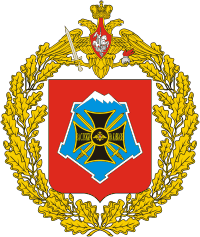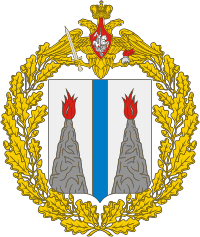
The 8th Guards Order of Lenin Combined Arms Army is an army of the Russian Ground Forces, headquartered in Novocherkassk, Rostov Oblast, within Russia′s Southern Military District, that was reinstated in 2017 as a successor to the 8th Guards Army of the Soviet Union's Red Army, which was formed during World War II and was disbanded in 1998 after being downsized into a corps. Military Unit в/ч 61877.
A tank corps was a type of Soviet armoured formation used during World War II.

The Leningrad Military District is a military district of the Armed Forces of the Russian Federation. In 2010 it was merged with the Moscow Military District, the Northern Fleet and the Baltic Fleet to form the new Western Military District. In December 2022, Defense Minister Sergey Shoigu proposed to reestablish it along with the Moscow Military District, a decision confirmed in June 2023 by Deputy Chief of the General Staff Yevgeny Burdinsky. On December 17, 2023 Vladimir Putin announced plans to recreate the Leningrad Military District as a reaction to Finland joining NATO. The district was formally reconstituted on February 26, 2024 by a Presidential Decree.

The North Caucasus Military District was a military district of the Russian Armed Forces from 1992-2010. Before 1992 it had been part of the Soviet Armed Forces since 1918. In 2010 it became the Southern Military District and lately also included the Black Sea Fleet and Caspian Flotilla.

The Far Eastern Military District was a military district of the Armed Forces of the Russian Federation. In 2010 it was merged with the Pacific Fleet and part of the Siberian Military District to form the new Eastern Military District.

The 51st Army was a field army of the Red Army that saw action against the Germans in World War II on both the southern and northern sectors of the front. The army participated in the Battle of the Kerch Peninsula between December 1941 and January 1942; it was destroyed in May 1942 with other Soviet forces when the Wehrmacht launched an operation to dislodge them from the peninsula. The army fought in the Battle of Stalingrad during the winter of 1942–43, helping to defeat German relief attempts. From late 1944 to the end of the war, the army fought in the final cutting-off of German forces in the Courland area next to the Baltic. Inactivated in 1945, the army was activated again in 1977 to secure Sakhalin and the Kuril Islands. Following the dissolution of the Soviet Union, the army continued in existence as a component of the Russian Ground Forces. The army was active during two periods from 1941 until 1997.
The 12th Guards Uman Orders of Lenin Red Banner and Suvorov Tank Division was a tank division of the Soviet Ground Forces. It drew its history from the World War II 16th Tank Corps. It was redesignated successively as 12th Guards Tank Corps (1943) and 12th Guards Tank Division (1946).
The 95th Rifle Division was a Red Army Rifle Division during World War II, formed three times. The division was first formed in November 1923 with the 6th Rifle Corps. It fought in the Winter War and the Soviet occupation of Bessarabia and Northern Bukovina. After Operation Barbarossa, the division fought in the retreat from Moldova and fought in the siege of Odessa and the siege of Sevastopol. It was destroyed during the siege of Sevastopol and was disbanded in late July 1942. The division was reformed in August 1942 from the 13th Motor Rifle Division NKVD and fought at the Battle of Stalingrad. For its actions during the battle, the division became the 75th Guards Rifle Division in March 1943. In April 1943, the division was formed a third time at Kaluga from the 121st Rifle Brigade. It fought in Operation Bagration.

The 19th Guards Mechanized Brigade is a formation of the Armed Forces of Belarus based in Zaslonovo, a few kilometers east of Lepiel. The brigade traces its history back to the 1942 formation of the 2nd Guards Mechanized Corps of the Soviet Army during World War II. Subsequent designations during the Cold War included 2nd Guards Mechanized Division and 19th Guards Tank Division. Following the Cold War, the 19th Guards Tank Division was relocated to Belarus and became part of their armed forces in 1992. Thereafter, the unit was reduced to a personnel and equipment cadre unit and titled the 19th Guards Base for Storage of Weapons and Equipment before being upgraded to a mechanized brigade in 2008.

The 252nd Rifle Division was the eighth of a group of 10 regular rifle divisions formed from cadres of NKVD border and internal troops as standard Red Army rifle divisions, very shortly after the German invasion, in the Moscow Military District.
The 29th Rifle Division was an infantry division of the Red Army and later the Soviet Army.
The 304th Rifle Division had its roots in the 109th Mechanized Division, which served before the Great Patriotic War as a mixed armor and infantry formation. Soon after the German invasion it was reorganized as a standard rifle division and renumbered as the 304th. It served in the southwestern part of the Soviet-German front for more than a year and a half, fighting under difficult conditions, including the German summer offensive of 1942. The division did not distinguish itself until Operation Uranus in late 1942 and the subsequent Operation Ring, in which it helped defeat the encircled German Sixth Army. In recognition of these successes, even before the German surrender at Stalingrad, it was raised to Guards status as the 67th Guards Rifle Division. A second 304th was raised six months later, based on a pair of rifle brigades, facing the German 17th Army in the Kuban. After helping to liberate this region the division continued in combat through Ukraine and Poland, winning its own distinctions at Zhitomir and an Order of the Red Banner, before ending the war near Prague.
The 280th Rifle Division was an infantry division of the Soviet Union's Red Army during World War II, formed twice. It was first formed in the summer of 1941 and destroyed in the Bryansk pocket in the fall of 1941. The division was reformed in late December, and served throughout the war before being disbanded in 1946.
The 341st Rifle Division was first formed in September 1941, as a standard Red Army rifle division, at Stalingrad. It was a "sister" unit to the 335th Rifle Division, which was formed at about the same time and place and shared a very similar combat path in its first formation. It was assigned to the southern sector of the Soviet-German front during the winter counteroffensive, but was effectively destroyed during the German spring offensive that formed the Izium Pocket, and was soon disbanded. The division was formed again almost exactly two years later, this time in the Karelian Front, facing Finland, and saw only limited action in the Continuation War before being assigned to coastal defense duties during 1945. The 341st Rifle Division continued to serve well into the Cold War, eventually being re-designated and becoming a motorized rifle division.

The 336th Independent Guards Bialystok Orders of Suvorov and Alexander Nevsky Naval Infantry Brigade is a brigade of the Russian Naval Infantry, formerly part of the Soviet Naval Infantry.
The 397th Rifle Division was an infantry division of the Red Army, active twice during 1941-45, fighting the German Operation Barbarossa.
The 414th Rifle Division was twice formed as an infantry division of the Red Army; very briefly in the winter of 1941/42, then from the spring of 1942 until after May 1945. It was officially considered a Georgian National division, having nearly all its personnel of that nationality in its second formation. After its second formation it remained in service in the Caucasus near the borders of Turkey and Iran in the 44th Army until the summer of 1942, when it was redeployed to help counter the German drive toward Grozny. As German Army Group A retreated from the Caucasus in January 1943 the division was reassigned to the 37th Army in North Caucasus Front, and during the fighting in the Taman Peninsula during the summer it served in both the 58th and 18th Armies, earning a battle honor in the process. It entered the Crimea during the Kerch–Eltigen Operation in November, and was awarded the Order of the Red Banner following the offensive that liberated that region in April and May 1944, fighting in the 11th Guards Rifle Corps of the Separate Coastal Army. After the Crimea was cleared the Coastal Army remained as a garrison and the 414th stayed there for the duration of the war. Postwar, it was relocated to Tbilisi, being renumbered as the 74th Rifle Division in 1955 and disbanded the following year.
The 119th Guards Rifle Division was formed as an elite infantry division of the Red Army in September 1943, based on the 11th Guards Naval Rifle Brigade and the 15th Guards Naval Rifle Brigade and was one of a small series of Guards divisions formed on a similar basis. Although the two brigades had distinguished themselves in the fighting south of Stalingrad as part of 64th Army they were moved to Northwestern Front in the spring of 1943 before being reorganized. After serving briefly in 22nd Army the division was moved to reinforce the 3rd Shock Army within the large salient that Army had created behind German lines after a breakthrough at Nevel in October. In the following months it fought both to expand the salient and defend it against German counterattacks in a highly complex situation. In January 1944 it was transferred to the 7th Guards Rifle Corps of 10th Guards Army, still in the Nevel region, after which it advanced toward the Panther Line south of Lake Peipus. During operations in the Baltic states that summer and autumn the 119th Guards was awarded both a battle honor and the Order of the Red Banner for its operations in Latvia. In March 1945 it joined the Kurland Group of Forces of Leningrad Front on the Baltic coast containing the German forces encircled in northwest Latvia. Following the German surrender it was moved to Estonia where it was disbanded in 1946.
The 176th Rifle Division was an infantry division of the Red Army, originally formed as part of the prewar buildup of forces, based on the shtat of September 13, 1939. The division completed its formation at Kryvyi Rih in the Odessa Military District and at the time of the German invasion of the Soviet Union was in the same area, assigned to the 35th Rifle Corps. Being relatively far from the frontier it escaped the early disasters and retreated mostly in good order through southern Ukraine into the autumn as part of 9th Army. It then took part in the counteroffensive against the overextended German Army Group South that liberated Rostov-na-Donu for the first time in December. When Army Group A began its summer offensive in 1942 the 176th fell back into the Caucasus region, losing much of its strength in the process, but finally helping to take up a firm defense along the Terek River and finally in front of Ordzhonikidze. As a result of this fighting the division, along with its artillery regiment, were awarded the Order of the Red Banner. After the German 6th Army was surrounded at Stalingrad the 176th advanced into the western Caucasus and entered the so-called Malaya Zemlya bridgehead south of Novorossiysk in the spring of 1943 where it helped to defeat the German Operation Neptun in April and in the autumn took part in the liberation of the city, for which it was redesignated as the 129th Guards Rifle Division.







